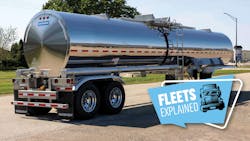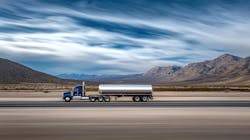A tank truck, also known as a tanker truck or simply a tanker, is a motor vehicle designed to transport liquid or gas cargo in bulk. Like all trucks and trailers, these tank trailers can come in different sizes and are made of durable materials like stainless steel, aluminum, or fiberglass-reinforced plastic.
But what separates them from other tractor-trailers and trucks is that tankers can safely carry cargo such as liquids, gases, and dry bulk across various terrains. This FleetOwner Fleets Explained entry details how tank trucks operate, are regulated, how much and what they can haul, and what future tank truck technology is being developed.
Because of the nature of their cargo, tanker truck transport and safety regulations are governed at both the federal level by the Federal Motor Carrier Safety Administration, part of the U.S. Department of Transportation, and at state levels.
According to the FMCSA, a tank vehicle is defined as: “Any commercial motor vehicle that is designed to transport any liquid or gaseous materials within a tank or tanks having an individual rated capacity of more than 119 gallons and an aggregate rated capacity of 1,000 gallons or more that is either permanently or temporarily attached to the vehicle or the chassis.” A large tanker can hold 5,000 to 11,600 gallons, and smaller tanks can hold 1,000 to 3,000 gallons.
This is part of FleetOwner's Fleets Explained, a Trucking 101 series to break down aspects of the trucking and fleet management industries. You can read more from the series, launched in May 2024, at fleetowner.com/fleets-explained. To submit topic ideas, clarifications, and corrections, email [email protected].
When are tank trucks used?
Taking a closer look at their cargo, tank trucks are commonly used for transporting a variety of materials, including fuel, chemicals, food-grade liquids, water, liquefied gases, and more.
When it comes to fuel and gases, the public often sees these tanks delivering fuel to gas stations. They also transport fuel from refineries to gas stations or liquefied gases such as propane, butane, and liquefied natural gas to various sites. Tanks can be specially designed to handle the low temperatures and high pressures associated with these substances. They can also safely carry chemicals, including industrial chemicals, acids, and other hazardous materials, often requiring specialized tanks to ensure safe transport.
Beyond chemicals, tank trucks transport food-grade liquids such as milk, juice, and other beverages. These tanks are typically made from stainless steel to maintain hygiene and prevent contamination. Lastly, tanks can be used to transport potable water to areas in need, such as construction sites, rural communities, or emergency response situations.
What safety and regulatory considerations are needed for tank trucks?
While tank trailers are used to transport potentially hazardous materials, their design and regulatory compliance help minimize the risk of environmental contamination. Properly maintained and operated tank trailers reduce the likelihood of spills and leaks, protecting natural resources.
Key safety features include pressure relief valves, spill containment systems, and specialized insulation to handle the specific properties of the cargo. Safety regulations can vary based on the nature of the load, including flammable or combustible liquids, acids, caustics, and poisonous substances. FMCSA enforces rules on vehicle operation, driver qualifications, and cargo handling to minimize risks on the road.
Additionally, tank truck drivers often require special training and certifications to handle hazardous materials safely. The trailers must be inspected regularly and are subject to regulations such as Title 49, which closely sets inspections and safety systems.
As safety and monitoring are critical on tank trailers, new technologies are being integrated into these tanks every year. Regulated safety features for tanker trucks include:
- Spill containment systems to prevent leaks during accidents
- Pressure relief valves to manage internal tank pressure
- Emergency shutoff mechanisms for quick response in emergencies
- Rollover protection to maintain tank integrity on impact
- Regular inspections and maintenance to ensure safety
- Driver training programs focusing on hazardous material handling
What are other design configurations for tank trucks?
Tank trailers come in various designs and configurations to handle different types of materials, including insulated tanks for temperature-sensitive products, pressurized tanks for gases, and compartmentalized tanks for transporting multiple products simultaneously. This versatility makes them suitable for a wide range of applications.
Tank trailers are designed with features that improve safety, efficiency, and ease of use. This includes advanced aerodynamics, ergonomic designs, and user-friendly features that make loading, unloading, and maintenance easier and safer. Advanced materials and construction techniques can enhance durability, reduce weight, and improve overall performance. For example, a tank trailer might use lightweight aluminum or stainless steel, which provides strength while reducing the trailer's overall weight, leading to better fuel efficiency and payload capacity.
What is the future of tank trucks?
Today, many manufacturers are exploring new tank trailer technology, including seal sensors, extensive camera coverage, automatic lighting, light-out detection, and more.
See also: Prototype tank trailer shows off seal monitoring, safety improvements
Future tank trailer technology includes features such as master control to manage and power all of the trailer’s technology features and digital verification that a manlid is sealed, which can help minimize how often employees need to scale tank trailers physically. Tank trailers also have the potential to include connected sensors such as temperature sensors, volumetric sensors, tire pressure monitoring, and wheel-end event monitoring.
Tank trailers are a key element of the transportation network because they provide a safe, efficient, and versatile way of moving bulk liquids and gases, supporting a wide range of industries and contributing to economic stability and growth. But safety and technology play a key role in the design, construction, and operation of the tank trailers.
About the Author

Adam Quinn
Adam Quinn is the senior director of tank trailer sales for Wabash. For the past 14 years, Quinn has been dedicated to customer-facing roles, with an emphasis on developing deep technical expertise within the tank trailer industry. Quinn remains engaged with industry needs through customer interactions and participation in National Tank Truck Carriers committee meetings.

